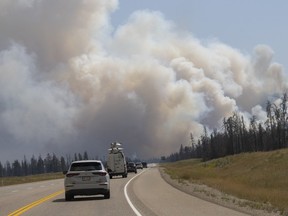Opinion: ‘Green’ forest policy turned Jasper into a tinderbox


Beginning of Article
Published Jul 26, 2024 • Last updated 1 day ago • 3 minute read

Photo by Greg Southam /Postmedia
Article content
The recent and ongoing disaster in Jasper National Park will undoubtedly generate a slew of commentary about the inevitable effects of climate change. While I readily agree that climate change is a huge factor in the spread of wildfires, in the current instance, it is not that simple.
I believe that a major part of the immediate problem in Jasper — which could have been considerably mitigated in all of the Rocky Mountain national parks — is the Parks Canada “green” policy of protecting the forest in all of the Rocky Mountain national parks as the primary objective of all of their current policies and operational activities.
Advertisement 2
This advertisement has not loaded yet, but your article continues below.
Article content
When the Rocky Mountain national parks were first established over one hundred years ago, the historical landscapes all featured a highly varied mix of vegetation, with forest on the montane slopes, but grasslands and low bushes dominant in all of the valleys and immediate uplands.
This natural state was the result of prairie fires frequently intruding into the front ranges, suppressing the forest growth in large areas of the parks. When the parks were established, though, this natural state was soon artificially altered by a policy of “protecting” all growth by the vigorous suppression of fires. The result was the gradual replacement of the valley bottom prairies and immediately adjacent uplands with ever-denser stands of coniferous trees (sometimes referred to by firefighters as “fireworks on a stick”).
This new, humanly created landscape gradually became accepted as the “natural state,” when, in reality, it is nothing of the sort. This shortsighted policy was vigorously opposed by provincial officials who managed Alberta’s forests, out of fear that the parks were becoming tinder boxes which would not only destroy the federal parks but, once started and out of control, would spread into adjacent Alberta forests. These provincial forests, in contrast, were being actively managed by a wide variety of means, including controlled burns, logging, and allowing natural fires to run their course if lives or private property were not at risk.
Advertisement 3
This advertisement has not loaded yet, but your article continues below.
Article content
Some 25 years ago, in my capacity then as deputy minister for Community Development, including responsibility for managing Alberta provincial parks, I was personally present at a meeting with senior Parks Canada and Alberta officials. At that meeting Fred McDougall, the Alberta deputy minister of Forestry, eloquently and passionately chastised the federal officials for their lack of foresight, stating unequivocally that their commitment to maximum preservation as the cornerstone of their forestry management policy was creating an explosive situation they would live to regret.
Several years ago, Waterton Lakes National Park experienced the first direct result of that failure to adapt. Now Jasper National Park is experiencing the same fate. Can Banff National Park dodge the bullet?
I seriously doubt that it will, as all three of these parks abut significant prairie regions, which for timeless millennia directly influenced the landscapes of the front ranges of the Rocky Mountains by channeling prairie fires into the valley bottoms and adjacent uplands.
Advertisement 4
This advertisement has not loaded yet, but your article continues below.
Article content
That is all gone now and instead, we have the reality of the humanly introduced “natural state” of our artificially managed current landscapes in the Rocky Mountain national parks. Massive forests throughout, steadily accumulating deadfall and forest-floor litter, and no relief in sight.
I deeply regret that we have apparently learned little from historical realities.
Dr. W.J. Byrne is a former deputy minister of Alberta Community Development and of Alberta Advanced Education (retired).
Article content
Share this article in your social network
Comments
Join the Conversation
Featured Local Savings
SDGs, Targets, and Indicators
1. Which SDGs are addressed or connected to the issues highlighted in the article?
- SDG 13: Climate Action
- SDG 15: Life on Land
2. What specific targets under those SDGs can be identified based on the article’s content?
- SDG 13.1: Strengthen resilience and adaptive capacity to climate-related hazards and natural disasters
- SDG 15.1: By 2020, ensure the conservation, restoration, and sustainable use of terrestrial and inland freshwater ecosystems and their services, in particular forests, wetlands, mountains, and drylands, in line with obligations under international agreements
3. Are there any indicators mentioned or implied in the article that can be used to measure progress towards the identified targets?
- Indicator for SDG 13.1: Number of deaths, missing persons, and directly affected persons attributed to disasters per 100,000 population
- Indicator for SDG 15.1: Proportion of important sites for terrestrial and freshwater biodiversity that are covered by protected areas, by ecosystem type
4. Table: SDGs, Targets, and Indicators
| SDGs | Targets | Indicators |
|---|---|---|
| SDG 13: Climate Action | 13.1: Strengthen resilience and adaptive capacity to climate-related hazards and natural disasters | Number of deaths, missing persons, and directly affected persons attributed to disasters per 100,000 population |
| SDG 15: Life on Land | 15.1: By 2020, ensure the conservation, restoration, and sustainable use of terrestrial and inland freshwater ecosystems and their services, in particular forests, wetlands, mountains, and drylands, in line with obligations under international agreements | Proportion of important sites for terrestrial and freshwater biodiversity that are covered by protected areas, by ecosystem type |
Explanation:
– The article discusses the spread of wildfires in Jasper National Park, highlighting the connection to climate change (SDG 13: Climate Action).
– It also mentions the impact on the forest ecosystem and the need for conservation and sustainable use of terrestrial ecosystems (SDG 15: Life on Land).
– Based on the content, the targets identified are SDG 13.1 and SDG 15.1.
– The indicators mentioned in the article that can be used to measure progress towards these targets are the number of deaths, missing persons, and directly affected persons attributed to disasters per 100,000 population (SDG 13.1 indicator) and the proportion of important sites for terrestrial and freshwater biodiversity that are covered by protected areas, by ecosystem type (SDG 15.1 indicator).
Source: edmontonjournal.com








